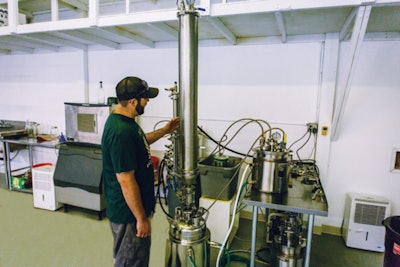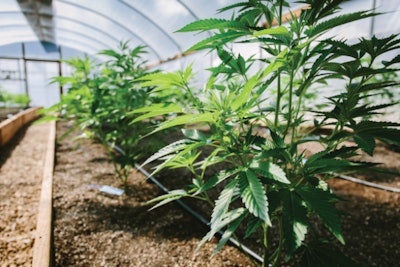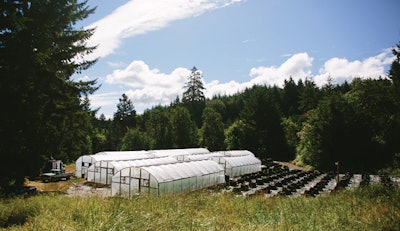
The debate between indoor, greenhouse and outdoor cultivation is a hot topic in the cannabis industry today. But there is one thing outdoor cultivators can have that is unavailable or unhelpful to the other types: goats.
“The goats serve a purpose for the grass,” says Andrew Felperin, co-owner, CEO and production manager at Apollo Grown, an outdoor-greenhouse-indoor cultivation and extraction business in Eugene, Ore. “Things grow like mad out here. Oregon trail, you know.”
Felperin lives on the farm and tends to the day-to-day of the cultivation operation while his partner Jared Dellinger, the other co-owner and head of marketing, lives in Hawaii.
The goats and other animals on the farm help with simple operations around the property: Six goats act as natural lawn-care specialists when they aren’t escaping from their pens; four dogs act as a security measure (although Felperin admits they do go after the odd delivery driver who forgets to check in ahead of time); and the pigs—well, they are there to be roasted during company luaus.
“I raise pigs every year so that we can have little barbecues and stuff for our employees,” Felperin explains. “After-work type of fun, you know?”
Now, after retrofitting the property to accommodate a cultivation business—including renovating a horse arena into an extraction lab—Apollo Grown is working to make a splash in an established Oregon market with its launch of branded extracts and flower.
Not Horsing Around
It isn’t always fun cookouts and chasing after escaped goats, or “rascals” as Felperin calls them. After buying the farm in August 2015, he and Dellinger spent a year leasing the property to two friends to operate the farm under the state’s medical caregiver program. It wasn’t until January 2016 that the company received its license to cultivate recreational cannabis.

It took a much shorter amount of time to get the processing license, Felperin says, because the Oregon Liquor Control Commission (OLCC), which oversees the state’s adult-use marijuana program, was able to streamline the process after initial delays.
“The moment we started our producer’s license application to the moment we got it was eight months,” Felperin recounts. Almost a year after securing the producer license, the duo applied for a processor’s license. “The moment we started our processor’s license and we got that … it took about two or three [months]. So you could see within a year how much the OLCC kind of dialed in their systems to get us the licenses.”
While the owners were waiting for their licenses, they kept busy by working on retrofitting the property. The former owner was a logger, so there were a few warehouses that were well-suited to quickly convert to indoor cultivation rooms, which allowed Apollo Grown’s medical caregivers to start cultivating and getting product out to medical dispensaries.
Then came the greenhouses. Currently, Apollo Grown operates 10 greenhouses manufactured by Oregon Valley Greenhouses: five measuring 50 feet by 20 feet, and five larger ones measuring up to 20 feet by 100 feet.
The first phase of retrofitting the property was making sure the land was laid out properly. Apollo Grown’s property lies on a hill facing Northeast, which sounds counter-intuitive to growing such a light-intensive crop, but Felperin says it works great for the operation.
“We definitely get exposure—a ton of exposure during the middle of the season. Like right now, we’re getting probably 13 or 14 hours of sunlight on these suckers,” he says. “As the seasons change …, it starts to get a little more shaded here, which we kind of like. It kind of tells the plants to hurry up and finish.”
To maximize the available light, the team worked the land into three tiers: Driving past the front gates of the farm will lead visitors to the first tier: the warehouses containing the indoor grow operation. Past that are the greenhouses and outdoor plants. Continue even further, and visitors will find the horse arena-now the extraction lab.
Apollo Grown cultivates its crops in soil amended with beneficial nematodes, predator mites and insects as part of its integrated pest management (IPM) plan, although it is planning a move to hydroponics in the near future.
Efficient Farming
According to Felperin, two of the biggest considerations in retrofitting the farm were water and electricity. Water was not an issue for the group: Streams, a well and rainwater collection give Apollo Grown all the water it could need. Having multiple sources of water also means that Felperin is not over-using any one source, which fits into the company’s resource efficiency and sustainability plan. The roof-runoff especially works in the company’s favor.
Oregon allows businesses to collect water runoff from any permitted buildings and reuse it, says Felperin. “They consider that your water,” he says. “Our barn is pretty massive. I would say it’s a 15,000- to 20,000-square-foot roof. And the house is probably 5,000 square feet. The permitted buildings down below are about 5,000 square feet each.”

Oregon can receive quite a bit of runoff during both the summer and winter. Apollo Grown collects and stores that water in aerated tanks to keep it from going stagnant. Felperin says that the farm can collect more than 2,000 gallons of rainwater by the time the outdoor growing season rolls in.
As for electricity, growing outdoors and in greenhouses allows the group to cut down on energy needs. The only true lighting need is in the indoor facilities. Apollo Grown uses 680W Fluence Bioengineering SPYDRx Plus lights. Felperin says using LEDs is the best way to cut down on power without affecting yield or quality. He recounts how a dispensary owner asked him questions about Apollo Grown’s flower products, and how the owner was shocked to hear they were grown under LEDs.
“We didn’t use any CO2 or anything, and we still got about a pound-and-a-half [per] light, which was really awesome,” he says. “They give us pretty much the exact THC content, the exact weight … but they save us a lot more in our energy costs.”
Felperin also uses gravity-feeding tanks instead of electric pumps to feed his crops. By putting the tank higher than where the irrigation lines run, gravity pushes water through the lines when the valve is open.
Water, electricity and security requirements should be considered together, not as separate components, he continues. A common mistake he has seen people make when retrofitting a farm for outdoor cultivation is completing steps one-by-one instead of all at once. For example, digging trenches in which to run electric lines, filling them in and then realizing you need to run water lines across the property.
“That hole you dug for the electric, you could have put a pipe in for water. … Or [the] same with your cameras,” he says.
Cost of Doing Business
While operating outdoors and using energy- and resource-efficient processes has allowed Apollo Grown to cut costs, some expenses cannot be curbed. For the Oregon company, a lot of the cost came from retrofitting the horse arena into the extraction lab.
“To have everything in line, from the machines to the material to the spot, the land that you’re doing it on, the property, to the mistakes and errors that are made—and they are made—I would just say it would be not wise to think that it wouldn’t be a six-figure cost to start. And it has been for us,” Felperin says.

The first step to retrofitting the arena was epoxying the floors to seal away any potential dust or other contaminants. Having a clean working environment was not a priority for horse trainers, but is crucial to a cannabis cultivation, especially an extraction-first company like Apollo.
The next big expenses were the high-end extraction and safety equipment needed to run a large-scale extraction lab. At several thousand dollars apiece, the bill adds up quickly. Apollo Grown has two $10,000 fume hoods, a $25,000 extraction machine and several ovens costing $10,000 each. Another oven and extraction machine on the way has added to the costs— which Felperin places at a quarter-million dollars—to get the lab up and running.
“It took a little time, Felperin says. “But I would say those are the numbers roughly we were working with, in our opinion, to do it right, to get ready for a relatively full-scale extraction company.”
Packaging also comes at a cost. For the scale at which Apollo Grown is operating, packaging costs are in the tens of thousands of dollars. However, Felperin says that by operating on a larger scale, the company gets a better value despite the higher cost. He says that buying smaller quantities often translates to bloated costs.
“Packaging for 500 [pieces] could cost [around] $7,000. But for 5,000 of them, it’s $10,000,” he says.
Science Matters
Knowledge is not something that is lacking at Apollo Grown: All senior staff have a college education and some, including Felperin, have master’s degrees. Biomechanics, mass communications, mechanical and software engineering, biochemistry and plain-old chemistry are all among their areas of expertise.
Having that knowledge, especially the chemists in the lab, has allowed Apollo Grown to finely tune its processes and cultivar selection.
“We have the luxury of deciding whether the bud that we are growing out there, how much of it and what specific strains can be used for processing for certain things,” Felperin says. “So we are starting to get more specific now on which strains we want to grow for live resin or the strains we want to do for shatter, or the strains for crumble or distillate or CO2, or anything, for that matter.”
Through its experiences, Apollo Grown has found that a high-wax cultivar such as Blue Dream has a better yield as a crumble than as a shatter. Felperin says that while the high wax content does reduce the THC levels in that particular crumble, it is filled with natural plant wax and terpenes.
For shatter, Apollo Grown prefers using cultivars with higher levels of THC and lower levels of waxes, such as OG Kush or Sour Diesel. “You blast those through the machine, the closed-loop system, and it comes out with more shatter,” he says. By removing the wax from the concentrate, Apollo Grown gets more material for shatter.
Having engineers on staff also helps the company avoid spending too much on outsourcing repairs. The main lab director has a degree in mechanical engineering. Felperin says that on top of overseeing the lab, he also acts as the resident “maintenance man” who fixes everything from cultivation equipment to cars. More than that, however, is how that knowledge allowed Apollo Grown to customize its extraction equipment.
“He has kind of retrofitted the extractor over time to make it incredibly our own. No one probably has our system directly,” Felperin says. “So that’s what he’s really good at: creating efficiency within machines or redundancy within machines.”
“He has actually saved us tens of thousands of dollars over the years just in his engineering skills,” he adds.
The key to managing such a team is making sure everything is flowing smoothly, which is what Felperin does on a daily basis. On top of being CEO, he also acts as the production manager. Communication between heads of cultivation and extraction specialists allows everyone to plan and prepare for what kind of extracts the company is going to put out, he says.
A Niche Discovery
Marketing those products to one of the more established markets can be a daunting challenge. Felperin says every region has different preferences, which is why the company offers a wide-range of products. “The more concentrate material that we can come up with, the more [niche] and better products we can make for our customers.”
While the company works with distributors to get its products around the state, Felperin, and Dellinger, who serves as head of marketing in addition to being co-owner, visit shops in their general area to tell their company’s story.
“We have learned a lot in these past couple of weeks just going around to dispensaries with face value,” Felperin says of the duo’s first two weeks of sales in mid-May. “That helps a lot in comparison to some sort of wholesaler—[and] we do have a wholesaler, but that’s because we can’t service the whole state.”

Competing with established brands hasn’t held the company back so far: Its monthly sales projections were 10,000 units (0.5g of concentrate or 1g of flower), but the co-owners quickly saw that those were low within the first two weeks.
“Thus far it hasn’t been too difficult to get shelf space in dispensaries,” Dellinger says. “There are a few established companies out there, but there are so many different factors which can get you shelf space in a dispensary, such as quality, price points, professionalism and brand image/recognition. We have spent a lot of time focusing on these different characteristics.”
Cultivators can reach consumers in many ways, and Apollo Grown is using multiple outlets. The company hired a marketing firm to handle social media campaigns, and it also advertises in magazines. Dellinger says Apollo Grown is looking into buying billboard advertising by September.
“Every brand has a different way that the consumers view them,” he says. “You just have to cover those characteristics and find a way to look different than every other company. There are so many types of products, and all you need to do is create a unique niche.”
And with its new “Sun Balls” product coming to market in a few months, Apollo Grown is likely to catch people’s attention.















